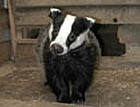Chinese hellebore and garden mammals
Mark discovers a novel way to keep badgers out of the garden


Muntjac deer and footballing fathers excepted, I am oddly relaxed about large mammals in the garden. Few sights could be more enchanting than the raccoon I once watched washing its dinner in the waters of an Italianate Connecticut pond. It was, perhaps, a pity that between its Horowitz-like fingers was a $200 koi carp, but then the pond was not mine.
Few sights, that is, apart from the badgers that have been barrelling over the lawns at dusk and dawn. This winter, they have scarcely grown sluggish. A dry-weather bonanza of burrowing bumblebees and cranefly larvae kept them on the qui vive into autumn. Since then, the lack of frost has brought a welter of worms. Their six months of gluttony have given us much pleasure and education?not least in the matter of badger locomotion.
It was the sage of Norwich, Sir Thomas Browne, who tackled this vexed question in his Pseudodoxia Epidemica ('Vulgar Errors') of 1646: 'That a Brock or Badger hath the legs of one side shorter than of the other, though an opinion perhaps not very ancient, is yet very generally received not only by theorists and unexperienced believers, but assented unto by most who have the opportunity to behold and hunt them daily.' Plenty of people, country folk included, did indeed believe the badger had legs that were shorter on one side than the other that would enable the beast to run, like some lumbering wall-of-death rider, along the base of a bank. Quite what Brock was meant to do on the flat is never mentioned.
Of course, the real thing shows no such deformity. All is in perfect working order beneath Brock's clerical coat ?too perfect, in fact, for some of our neighbours, who are growing tired of all the twilight excavations. According to the Buckinghamshire Badger Group (www.bucks-badgers.org.uk), the kindest way to keep badgers out of the garden is to have your dog urinate along their favoured routes or, better still, to do it yourself. No need for bait, trap and gas; just a light hosing and it's game, match and sett to the gardener. But, apparently, only the male product will do: organic badger deterrence is not an equal-opportunities employer.
For all that, a flash of black-and-white can be a distraction from the proper business of horticulture. On March 15, 1869, the French missionary and naturalist Père Armand David came across a sensational new hellebore while clambering around at 8,000ft on the slopes of Baoxing in China. In his journal entry for that day, the good father noted he had seen nothing that, botanically speaking, was out of the ordinary. We must forgive him this rare lapse of judgment. He was probably feeling a trifle jaded. Shortly before discovering the hellebore, he had been shown something that would burn up anyone's reserves of curiosity and credulity: the pelt of what he described as a large 'black and white bear'.
He was the first Westerner to clap eyes on the giant panda and, quite understandably, felt unmoved by a mere hellebore (although he still had the presence of mind to send dried specimens of the plant to Paris).
It was not until the hellebore craze hit us toward the end of the last century that we began to ruminate on Père David's discovery. Never having been seen alive outside its mountain fastness, Helleborus thibetanus assumed the dimensions of an Oriental myth. But, just as we were losing faith in its ever being rediscovered, it was spotted amid the snowy slopes of Baoxing in the winter of 1989 by the tireless plant explorer Mikinori Ogisu.
Exquisite houses, the beauty of Nature, and how to get the most from your life, straight to your inbox.
With this rarity now road-tested and legally obtainable, I can at last commend it highly enough. As I write, its ruffs of apple-green leaves are capped with nodding bells that resemble rose quartz in their blushing translucence. It is resilient, cold-hardy and needs only one caveat: its leaves are meant to die off in summer, so please do not despair of it.
We have it on a cool clayey soil with a little added grit and compost, beside evergreen ferns such as Polystichum tsussimense, and drifting through our modest bamboo grove. On a breezy March morning, its apple-blossom-pink flowers engage in an ethereal dance among the bottle-green fronds and golden canes.
Long may it continue? at least, that is, until Brock turns vegetarian, or panda exports increase.
Country Life is unlike any other magazine: the only glossy weekly on the newsstand and the only magazine that has been guest-edited by His Majesty The King not once, but twice. It is a celebration of modern rural life and all its diverse joys and pleasures — that was first published in Queen Victoria's Diamond Jubilee year. Our eclectic mixture of witty and informative content — from the most up-to-date property news and commentary and a coveted glimpse inside some of the UK's best houses and gardens, to gardening, the arts and interior design, written by experts in their field — still cannot be found in print or online, anywhere else.
